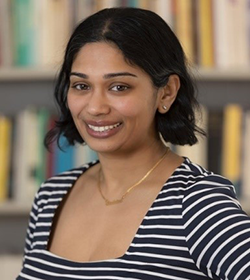Sohini Ramachandran, Ph.D., is director of the Center for Computational Molecular Biology and associate professor of biology and computer science at Brown University in Providence, Rhode Island. She is also a recent recipient of the Presidential Early Career Award for Scientists and Engineers (PECASE). Dr. Ramachandran researches the causes and consequences of human genetic variations using computer models. Starting with genomic data from living people, her lab applies statistical methods, mathematical modeling, and computer simulations to discover how human populations moved and changed genetically over time.

Sohini Ramachandran, Brown University. Credit: Danish Saroee/Swedish Collegium for Advanced Study.
Dr. Ramachandran and her team focus on further uncovering how the genetic “architecture,” or composition of traits, varies among people with different ancestries. Variations in the genetic composition of disease-causing genes can make individuals respond differently to the same therapy, and understanding these variations could help doctors recommend the best treatment for each patient.
Many of the large genome-wide association studies that have looked for the basis of traits or diseases have been in populations of European ancestry, with the assumption that their genetic architecture is the same across populations. However, this isn’t necessarily the case. Most diseases are caused by the interaction of many genetic variants. As a result, people who have different ancestries and the same disease may share some disease-causing variants but have population-specific variants that also play a role in the disease.
Dr. Ramachandran is excited to bring her knowledge of human evolutionary histories into studying genetic variation to better understand and potentially treat diseases and to identify adaptive mutations. She says evolutionary histories can help researchers make sense of data from the genome-wide association studies used to investigate diseases, understand why results from these studies are often difficult to replicate, and determine if results apply only to certain populations. “The genome-wide association studies have a lot of downstream effects because some of the results from these studies are affecting decisions that are being made in clinics, and it’s not clear if those results are relevant to everyone,” she says.
For Dr. Ramachandran, receiving a PECASE highlights the importance of statistical and computational work in human genetics and disease and reinforces the value of including evolutionary biology in modern medical practices.
Dr. Ramachandran’s research is supported in by part NIGMS grants R01GM118652 and P20GM109035.
Original post https://alertarticles.info

